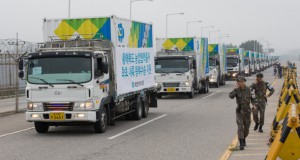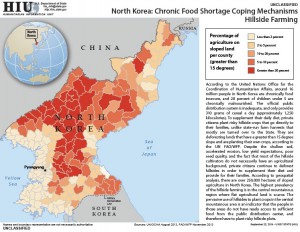By Benjamin Katzeff Silberstein
During the past few months, the World Food Program (WFP) has made reoccurring pleas for increased food assistance to North Korea to alleviate the food shortages expected from a severe summer drought. The North Korean government made similar statements and claimed that the drought was the worst one to occur in 100 years. Aid to the country was subsequently increased from the originally planned level, due to the drought. But now, one North Korean official is saying that food production ended up increasing, after all, thanks to agricultural reforms.
A recent brief by the Institute for Far Eastern Studies at Kyungnam University (IFES) cites a July issue of Tongil Sinbo, a North Korean state-run weekly newspaper. There, Chi Myong Su, director of the Agricultural Research Institute of the Academy of Agricultural Sciences in the country, says that
“the effectiveness of field management system (pojon) from cooperative farm production unit system (bunjo) is noticeable and succeeded in increasing grain production despite the adverse weather conditions.”
The article cited by IFES highlights the smaller work-team structure as key to the success of the reforms. Also, it almost outright states that greater economic incentives were the main factor (although they call it “enthusiasm” and “patriotism”):
“Despite the adverse weather conditions last year, the high grain yield was possible due to implementation of scientific farming methods and field management system to increase enthusiasm of farmers,” and “based on this experience, many cooperative farms across the country will expand subworkteam management system to field management system.”
This is interesting for several reasons.
First, the agricultural reforms seem increasingly pronounced. Though other reforms were reportedly backtracked earlier this year, the government seems eager to claim success for the road travelled in agriculture.
I have written elsewhere that the data doesn’t necessarily support a claim that reforms are working. There is still reason to be skeptical – after all, a North Korean government official claiming that his government’s policies are working is not surprising – but even the claim itself is interesting.
Second, the statement raises questions about monitoring and data gathering capacities, both of the regime and relief organizations in Pyongyang. Again, just a few months ago, alarm bells were ringing about a potential food shortage, and now, a regime official claims that food production has increased. What was the basis of the WFP and regime claims that a food shortage was imminent a few months ago, and what has changed since those claims were made?
Another recent IFES brief also deals with North Korean press reports about the agricultural reforms. It quotes a Rodong Sinmun article from earlier in the summer that brings up some adjustment problems that farmers have had, such as learning how to properly use fertilizers. The most interesting part in my opinion is the following:
The newspaper stressed that “when all farmers claim ownership of their field and subworkteam, one can create innovation in the farming operations.”
Thus, it seems like Pyongyang wants to encourage experimentation and diversity in production methods. This would be a potentially important step towards more efficient agriculture. Perhaps it is part of a pattern. Provinces have reportedly gotten significant leeway in setting up their respective special economic development zones, which could also be a way to encourage experimentation in policies and management methods.
According to the Tongil Sinbo article, reforms are set to expand further in the country given the alleged success. Perhaps it won’t be too long before we can learn more about them through assessments by multilateral organizations like WFP.


